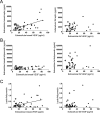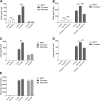Adipokines and Vascular Endothelial Growth Factor in Normal Human Breast Tissue in Vivo - Correlations and Attenuation by Dietary Flaxseed
- PMID: 27059487
- PMCID: PMC4933741
- DOI: 10.1007/s10911-016-9352-9
Adipokines and Vascular Endothelial Growth Factor in Normal Human Breast Tissue in Vivo - Correlations and Attenuation by Dietary Flaxseed
Abstract
Exposure to sex steroids increases the risk of breast cancer but the exact mechanisms are yet to be elucidated. Events in the microenvironment are important for carcinogenesis. Diet containing phytoestrogens can affect the breast microenvironment and alter the risk of breast cancer. It has previously been shown that estrogen regulates extracellular levels of leptin, adiponectin, and VEGF in normal breast tissue in vivo. Whether these proteins correlate in breast tissue in vivo or if diet addition of flaxseed, a major source of phytoestrogens in Western diets, alters adipokine levels in breast tissue are unknown. We used microdialysis to sample proteins of normal human breast tissue and abdominal subcutaneous fat in situ in 34 pre-and postmenopausal women. In vitro, co-culture of breast cancer cells and primary human adipocytes was used. In vivo, in normal breast tissue, a significant positive correlation between VEGF and leptin was detected. No correlations were found in fat tissue. Co-culture of adipocytes and breast cancer cells per se increased the secretion of VEGF and leptin and enhanced the effects of estradiol compared to culture of either cell type alone. In vitro, inhibition of VEGF diminished the release of leptin while inhibition of leptin had no influence on VEGF secretion. The levels of leptin decreased and adiponectin increased after a dietary addition of 25 g of flaxseed/day for one menstrual cycle. We conclude that VEGF and leptin correlate significantly in normal human breast tissue in vivo and that dietary addition of flaxseed affect adipokine levels in the breast.
Keywords: Adiponectin; Diet; Estrogen; Flaxseed; Leptin; Microdialysis.
Figures




Similar articles
-
Dietary flaxseed and tamoxifen affect the inflammatory microenvironment in vivo in normal human breast tissue of postmenopausal women.Eur J Clin Nutr. 2019 Sep;73(9):1250-1259. doi: 10.1038/s41430-019-0396-y. Epub 2019 Jan 28. Eur J Clin Nutr. 2019. PMID: 30692654
-
Estradiol affects extracellular leptin:adiponectin ratio in human breast tissue in vivo.J Clin Endocrinol Metab. 2014 Sep;99(9):3460-7. doi: 10.1210/jc.2014-1129. Epub 2014 May 5. J Clin Endocrinol Metab. 2014. PMID: 24796929
-
Flaxseed and its lignans inhibit estradiol-induced growth, angiogenesis, and secretion of vascular endothelial growth factor in human breast cancer xenografts in vivo.Clin Cancer Res. 2007 Feb 1;13(3):1061-7. doi: 10.1158/1078-0432.CCR-06-1651. Clin Cancer Res. 2007. PMID: 17289903
-
Role of adipokines and cytokines in obesity-associated breast cancer: therapeutic targets.Cytokine Growth Factor Rev. 2013 Dec;24(6):503-13. doi: 10.1016/j.cytogfr.2013.10.001. Epub 2013 Oct 21. Cytokine Growth Factor Rev. 2013. PMID: 24210902 Review.
-
Targeting the adiponectin:leptin ratio for postmenopausal breast cancer prevention.Front Biosci (Schol Ed). 2009 Jun 1;1(1):329-57. doi: 10.2741/S30. Front Biosci (Schol Ed). 2009. PMID: 19482706 Review.
Cited by
-
The pleiotropic roles of adipocyte secretome in remodeling breast cancer.J Exp Clin Cancer Res. 2022 Jun 14;41(1):203. doi: 10.1186/s13046-022-02408-z. J Exp Clin Cancer Res. 2022. PMID: 35701840 Free PMC article. Review.
-
Randomized Phase IIB Trial of the Lignan Secoisolariciresinol Diglucoside in Premenopausal Women at Increased Risk for Development of Breast Cancer.Cancer Prev Res (Phila). 2020 Jul;13(7):623-634. doi: 10.1158/1940-6207.CAPR-20-0050. Epub 2020 Apr 20. Cancer Prev Res (Phila). 2020. PMID: 32312713 Free PMC article. Clinical Trial.
-
Adipose Tissue Paracrine-, Autocrine-, and Matrix-Dependent Signaling during the Development and Progression of Obesity.Cells. 2023 Jan 25;12(3):407. doi: 10.3390/cells12030407. Cells. 2023. PMID: 36766750 Free PMC article. Review.
-
Dietary flaxseed and tamoxifen affect the inflammatory microenvironment in vivo in normal human breast tissue of postmenopausal women.Eur J Clin Nutr. 2019 Sep;73(9):1250-1259. doi: 10.1038/s41430-019-0396-y. Epub 2019 Jan 28. Eur J Clin Nutr. 2019. PMID: 30692654
-
Dense breast tissue in postmenopausal women is associated with a pro-inflammatory microenvironment in vivo.Oncoimmunology. 2016 Sep 2;5(10):e1229723. doi: 10.1080/2162402X.2016.1229723. eCollection 2016. Oncoimmunology. 2016. PMID: 27853653 Free PMC article.
References
-
- Cuzick J, Sestak I, Forbes JF, Dowsett M, Knox J, Cawthorn S, et al. Anastrozole for prevention of breast cancer in high-risk postmenopausal women (IBIS-II): an international, double-blind, randomised placebo-controlled trial. Lancet. 2014;383(9922):1041–1048. doi: 10.1016/S0140-6736(13)62292-8. - DOI - PubMed
Publication types
MeSH terms
Substances
LinkOut - more resources
Full Text Sources
Other Literature Sources
Medical

